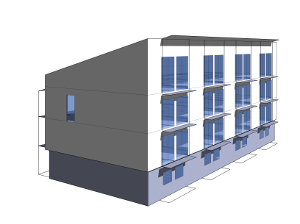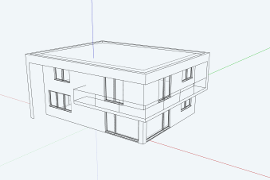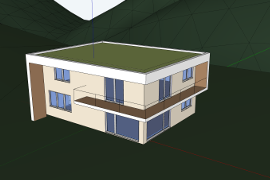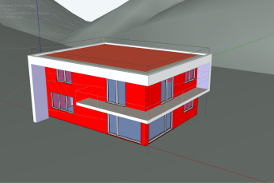The 3D modelling tool for the PHPP: designPH
The designPH plugin has been developed by the Passive House Institute to provide a 3D model interface for entering building geometry into PHPP. The benefits of the tool are two-fold; firstly it will simplify the process of entering data into PHPP and secondly it will provide preliminary feedback on the performance of the design within SketchUp.
|
|
|
Analysis process
The model geometry is marked-up with thermal properties, with the aid of some automatic analysis functions. The tool uses an heuristic algorithm to infer element types, temperature zones and area groups, in order to save input time, but these can be over-ridden by the user if required. The external heat loss areas and the treated floor area are collected and formatted for export to PHPP. Each window is analysed to identify external shading objects and these are exported as input parameters for each of the three key shading types in PHPP (reveal, overhang and horizontal object).
|
|
|
|
|
design |
present |
analyse |
A 3D interface for PHPP
The export function saves model data to a PPP file, the interchange format developed by the Passive House Institute, which can then be imported into a PHPP model. Through this process, a 3D digital model can easily be converted to a PHPP workbook. After importing a model, the primary data on the Areas, Windows & Shading sheets will be mostly complete, enabling a result for specific space heat demand to be calculated quickly, without the need for much direct data-entry. The advantages of this approach over entering the geometry directly into PHPP are, firstly that it should save time on data-entry and secondly that it is possible to visually verify in the 3D model that all the heat-loss surfaces have been correctly taken into account.
An iterative design tool
An additional feature of the tool is that a simplified energy balance is provided within the 3D modelling environment. This facilitates a more effective iterative design process, allowing the user to get an immediate idea of the building's energy performance, and rule out poorly performing design options, before exporting to PHPP to fine-tune the design and make the verification.
User interface
The user interface provides access to the functions of the tool via the standard SketchUp application menus, context menus and graphical toolbars. The details of the model geometry and energy balance calculations can be interrogated using the web-dialog windows provided. These also allow the components library and other model properties to be edited.
Summary of features
- Work with a new or existing SketchUp model (some simplifications may be required)
- Automatic recognition of temperature zones, element types and area groups
- Schedules of areas, windows / doors and TFA components and recognition of external shading objects
- Rendering of heat-loss areas to indicate their area group or status
- Export geometry and shading data to PHPP via PPP file format, with conversion of elements to meaningful
dimensions and quantities that can be manipulated in PHPP - Tools to insert and edit window & door components, with user-defined properties or from standard libraries
- Simple energy balance within the tool and warnings about high-levels of glazing that would lead to overheating
The designPH can be purchased together with PHPP. Online ordering
More information can be found on: www.designph.org










